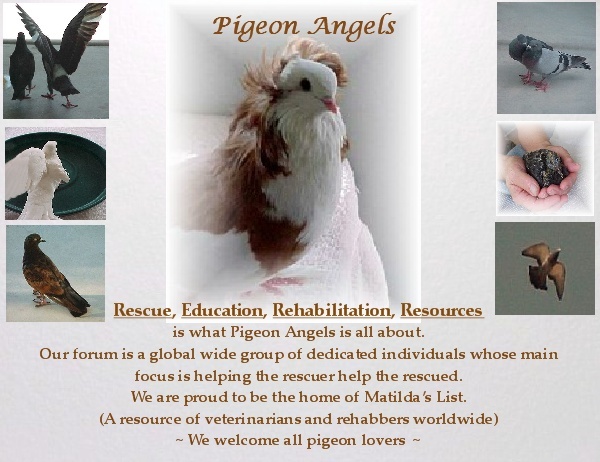PP and his mate sneaked onto my second floor balcony in the winter of 1995/1996, staking out a disused plant tub hidden behind a large fan palm for their nest site. First I knew was when, on a bitter cold January day, I went out to get a spare flowerpot, prompting PP's swift exit. He left behind him a small feathery thing, the like of which I'd never seen. This later became affectionately known as 'Tatty', for her breast feathers never did grow quite right and always had a look of disarray. Hardly the time of year or conditions to be raising a youngster, but I guess they must have felt safe and sheltered, for I probably hadn't even opened that door for weeks.
I started leaving out a little dish of food ('mixed corn' from a local pet store) and water, and PP stopped fleeing the nest within a very short time. He just seemed to understand, very quickly, that I meant him and his family no harm and, indeed, wanted to help them out.
I did know a little about pigeons in a theoretical way, but apart from my visiting homer the previous year, had not had the opportunity to observe them in such close proximity. This was still pre-internet times for me, and I knew nothing of dummy eggs, nor just how many young a pair could produce in a year in what were, for them, pretty much an ideal situation. He stayed with me for about 18 months, outliving one mate, acquiring another and fathering many 'little PPs'.
(PP got his name by accident. Sometimes I would call him "pidgie, pidgie!" from the window, and he would jump down off the railing and, often, get a few peanuts. So I guess he figured that it was 'pigeon English' for peanuts. Thus, he became PP.)
PP was so trusting and (with me) human-friendly, I was amazed! His mates, however, were tolerant but never very approachable. I think it's because he was always there when I was about, whereas the 'shift system' meant I saw less of the hens. I could move his plant tub around to clean the balcony, with him and babies still in it, give him a little preen around his neck or just sit and talk to him and watch him caring for his youngsters. If any visitor looked out through the glazed door, however, he would prepare for flight. I had a handyman rehang the door one time, and PP was ready to go - but I stood outside with him, and he stayed put on his nest the whole time. Of course, the offspring grew up with me around, so they had no fear of me either. That was fine, but then they hung out and added numbers to the local flock, which was not universally approved.
I saw 'potty training' (Oh for digital cameras!) when a tiny fuzzball backed out from under PP, to gentle pecks on the back, did his small poop over the edge of the nest then crawled back under his father. I see now why so many pigeons take the few steps back before they poop! I saw him training the youngsters to heed the alarm call - to recognize the 'huh' sound as a signal to hide. I learned that a pigeon will look after his fledged young for at least a couple of weeks after they are flying: when one got caught in bad weather and couldn't make it back to the balcony near dark, PP went to look for him and stayed huddled against a wall on the patio with him until morning.
Sadly, however, one morning he set out for his regular exercise flight and never returned. With a mate and two youngsters to feed, I know he would have come back if he could, so after another day had gone by I knew I had lost a dear pigeon friend. But, he left me with an understanding and love of pigeons which I could never have experienced without him.
Old pics:
PP posing for the camera

With his first mate, on the 'roof' of his domain, put up to keep the family dry.

Feeding time

PP with two youngsters - I put an old tray against the pot and they would get on the pot and then slide down the tray.



